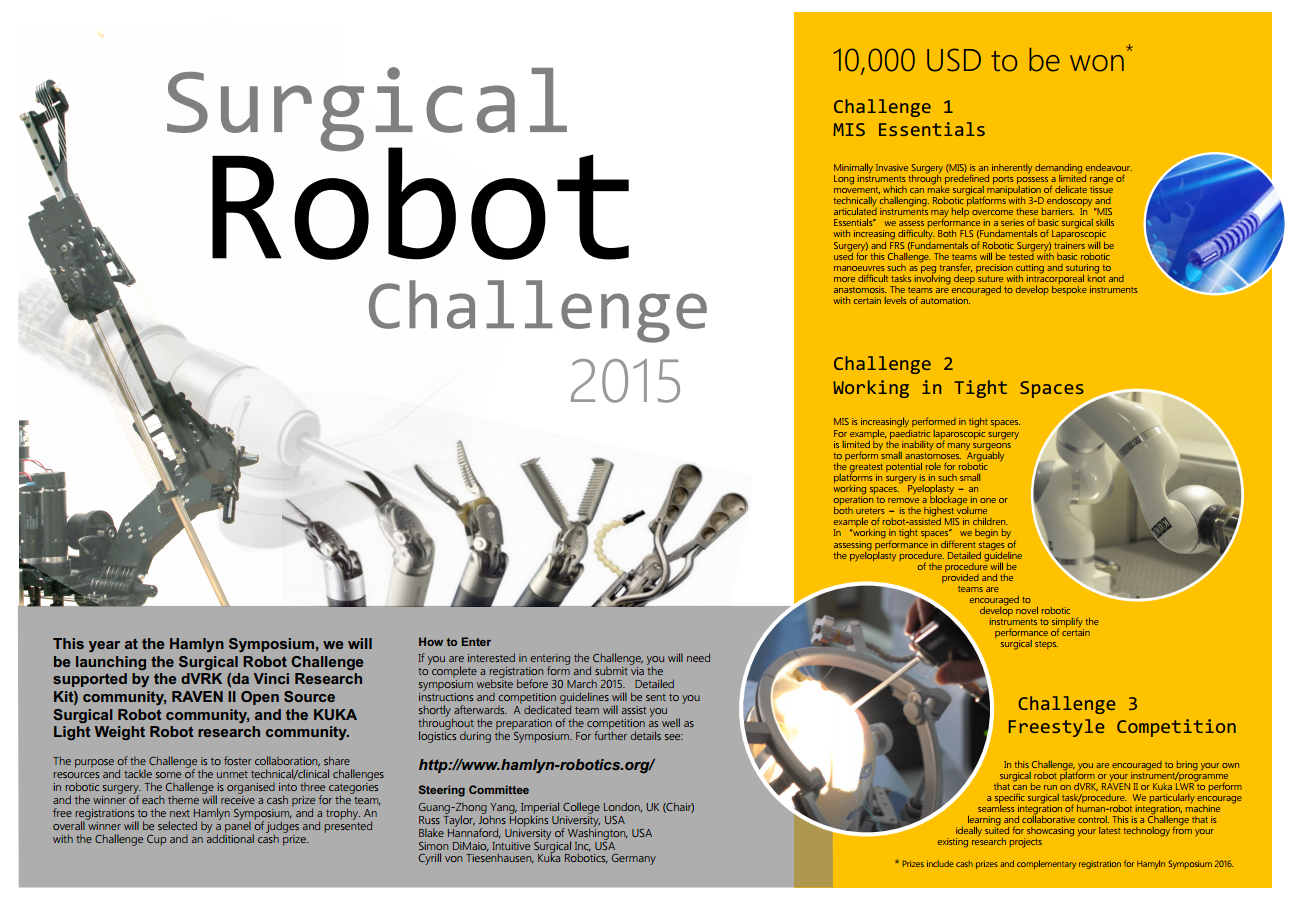Surgical Robotics Challenge at Hamlyn
"This year at the Hamlyn Symposium, we will be launching the Surgical Robot Challenge supported by the dVRK (da Vinci Research Kit) community, RAVEN II Open Source Surgical Robot community, and the KUKA Light Weight Robot research community. The purpose of the Challenge is to foster collaboration, share resources and tackle some of the unmet technical/clinical challenges in robotic surgery. The Challenge is organised into three categories and the winner of each theme will receive a cash prize for the team, free registrations to the next Hamlyn Symposium, and a trophy. An overall winner will be selected by a panel of judges and presented with the Challenge Cup and an additional cash prize.
Challenge 1: MIS Essentials
Minimally Invasive Surgery (MIS) is an inherently demanding endeavour. Long instruments through predefined ports possess a limited range of movement, which can make surgical manipulation of delicate tissue technically challenging. Robotic platforms with 3-D endoscopy and articulated instruments may help overcome these barriers. In“MIS Essentials” we assess performance in a series of basic surgical skills with increasing difficulty. Both FLS (Fundamentals of Laparoscopic Surgery) and FRS (Fundamentals of Robotic Surgery) trainers will be used for this Challenge. The teams will be tested with basic robotic manoeuvres such as peg transfer, precision cutting and suturing to more difficult tasks involving deep suture with intracorporeal knot and anastomosis. The teams are encouraged to develop bespoke instruments with certain levels of automation.
Challenge 2: Working in Tight Spaces
MIS is increasingly performed in tight spaces. For example, paediatric laparoscopic surgery is limited by the inability of many surgeons to perform small anastomoses. Arguably the greatest potential role for robotic platforms in surgery is in such small working spaces. Pyeloplasty – an operation to remove a blockage in one or both ureters – is the highest volume example of robot-assisted MIS in children. In “working in tight spaces” we begin by assessing performance in different stages of the pyeloplasty procedure. Detailed guideline of the procedure will be provided and the teams are encouraged to develop novel robotic instruments to simplify the performance of certain surgical steps.
Challenge 3: Freestyle Competition
In this Challenge, you are encouraged to bring your own surgical robot platform or your instrument/programme that can be run on dVRK, RAVEN II or Kuka LWR to perform a specific surgical task/procedure. We particularly encourage seamless integration of human-robot integration, machine learning and collaborative control. This is a Challenge that is ideally suited for showcasing your latest technology from your existing research projects.
How to Enter
If you are interested in entering the Challenge,
you will need to complete a registration form and submit via the
symposium website before 30 March 2015. Detailed instructions and
competition guidelines will be sent to you shortly afterwards. A
dedicated team will assist you throughout the preparation of the
competition as well as logistics during the Symposium."
Steering Committee
- Guang-Zhong Yang, Imperial College London, UK (Chair)
- Russ Taylor, Johns Hopkins University, USA
- Blake Hannaford, University of Washington, USA
- Simon DiMaio, Intuitive Surgical Inc, USA
- Cyrill von Tiesenhausen, Kuka Robotics, Germany



Comments